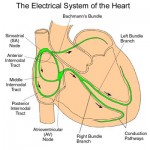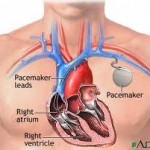|
Conduction disturbance can lead to abnormal heart rhythms called arrhythmias. Arrhythmias that are too slow sometimes require a pacemaker that delivers regularly timed electrical impulses to bring the heart rate up to normal. When the heart rhythm is too fast, an implantable defibrillator can deliver an electrical shock to restore a normal heart rhythm. These are called ICD’s the underlying problem with the heart in myotonic dystrophy s fibrosis and abnormalities in the heart that seem to specifically and primarily affect the conduction system, the specialized tissue that allows for electricity to flow through the heart. It leads to a higher risk of arrhythmias, and a small percentage of patients develop cardiomyopathy.” The most serious arrhythmias are those that cause the lower chambers of the heart — the ventricles — to stop beating or to beat too slowly to sustain life; or to beat in a fast, uncoordinated and ineffective way. Both these fast and slow ventricular arrhythmias can lead to sudden death, and people with MMD1 unfortunately are at increased risk for that. Here is a great video from the Library at the Myotonic Dystrophy Foundation. This video talks about the heart and the electrical issues in the heart with Myotonic Dystrophy |
|
Pacemakers and Defibrillators: Pacemakers are generally used to manage a heartbeat that is too slow or irregular, caused by disorders that disrupt the heart’s normal electrical conduction system. This condition known as bradicardia can cause inadequate blood flow through the body creating symptoms such as fatigue, dizziness, and fainting.
|
CK Recommendations for Patients with DM from Scottish Workgroup
|
|
*This information was copied from the evidence based clinical guidelines developed by the Collaborative Project Byall Scottish Clinical Genetics Services.
|
Richard Weston's Myotonic Dystrophy Blog
Information About Myotonic Dystrophy Type 1




